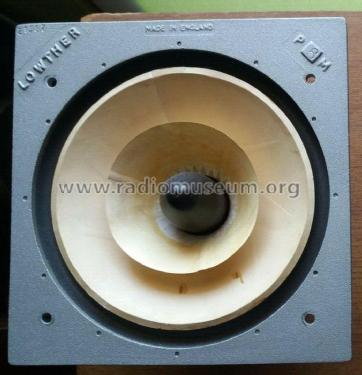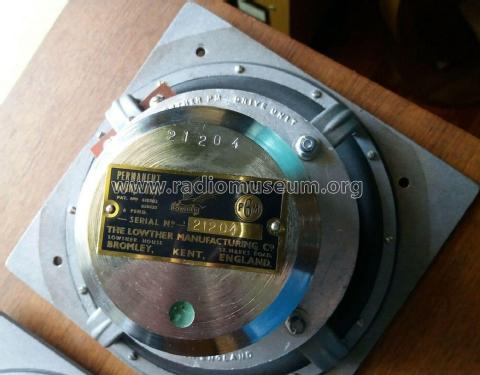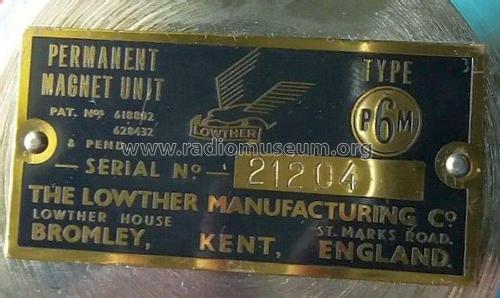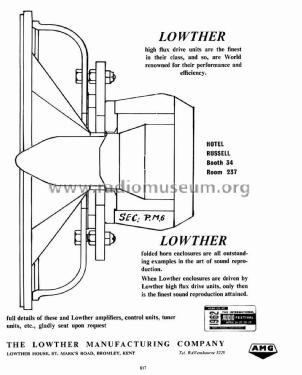Lowther Driver Unit PM6
Lowther Manufacturing Co; Kent
- Land
- Grossbritannien (UK)
- Hersteller / Marke
- Lowther Manufacturing Co; Kent
- Jahr
- 1956 ?
- Kategorie
- Lautsprecher, Kopfhörer oder Ohrhörer
- Radiomuseum.org ID
- 340857
- Hauptprinzip
- NF-Verstärkung
- Wellenbereiche
- - ohne
- Betriebsart / Volt
- Keine Stromversorgung
- Lautsprecher
- Dynamischer LS, keine Erregerspule (permanentdynamisch) / Ø 6 inch = 15.2 cm
- Material
- Spezielles Material - in den Bemerkungen beschrieben.
- von Radiomuseum.org
- Modell: Lowther Driver Unit PM6 - Lowther Manufacturing Co; Kent
- Form
- Chassis - Einbaugerät
- Bemerkung
-
Lowther PM6 Drive Unit
The special design of the PM 6 drive unit preserves the fundamental harmonic relationship throughout the entire audio range, thereby ensuring smooth, natural sound. Designed especially to meet the requirements of horn-loaded operation, the PM 6 should never be used as a conventional direct radiator.
Catalogue Circa 1972.Specification:
- Flux density: 17,500 gauss
- Total flux: 196,000 Maxwells
- Impedance: 15 ohms
- Frequency range: 20Hz - 18,000Hz
- Power handling: 6 watts
- Nettogewicht
- 3 kg / 6 lb 9.7 oz (6.608 lb)
- Literaturnachweis
- - - Manufacturers Literature (Catalogue Circa 1972)
- Autor
- Modellseite von Gary Cowans angelegt. Siehe bei "Änderungsvorschlag" für weitere Mitarbeit.
- Weitere Modelle
-
Hier finden Sie 56 Modelle, davon 51 mit Bildern und 2 mit Schaltbildern.
Alle gelisteten Radios usw. von Lowther Manufacturing Co; Kent
Forumsbeiträge zum Modell: Lowther: Lowther Driver Unit PM6
Threads: 1 | Posts: 1
Lowther PM6 Reviewed in HiFi News December 1957, Page 365.
LOWTHER PM6
Made by the Lowther Manufacturing Company, Lowther House, St. Marks Road, Bromley, Kent; price is £18 18s. 0d.
This is the most interesting 8-inch unit of extremely advanced design. It is a direct descendant of the revolutionary moving coil of P.G.A.H. Voigt way back in 1915.
The general idea is a design embodying all the necessary features within reason, to give a very good performance rather than a compromise falling within some specified price limit. Even so, it doesn't cost the earth!
There are six main departures from ordinary practice, and the writer cannot recall any other speaker unit embodying all of these features, except the other units in the Lowther range. First will be noticed the twin cone assembly, which most readers will recognise as a means of both improving and increasing the high-frequency response. Increasing, since at high frequencies only the moving coil and small cone will vibrate, the main cone flexing, effecting a considerable reduction in moving mass; improving, since the behaviour of a small cone is better than a large one at these frequencies. A large cone can be made to vibrate at high frequencies, but it is almost certain to exhibit several audible resonances.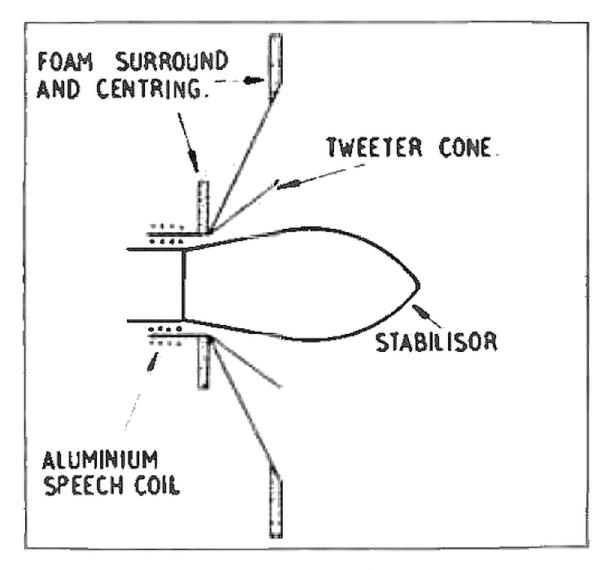 The second noticeable feature is the "stabiliser", a (non-magnetic) shaped continuation of the centre pole, partially filling the space inside the small cone. Shaped plugs in this position have been seen before, but most of them merely spread the high note beam produced from the central area of the cone by preventing interference between the sound output from opposite sides of the tweeter cone.
The second noticeable feature is the "stabiliser", a (non-magnetic) shaped continuation of the centre pole, partially filling the space inside the small cone. Shaped plugs in this position have been seen before, but most of them merely spread the high note beam produced from the central area of the cone by preventing interference between the sound output from opposite sides of the tweeter cone.
In this case, the design goes much farther and effectively horn loads the tweeter cone, i.e., the space between the stabiliser and the small cone expands at a carefully controlled rate. It is to be noted that this " horn" starts right down inside, as even the speech tube radiates considerable sound energy. This "horn loading" both increases the efficiency, and smoothes the response, of the tweeter cone, hence the term “stabiliser".
The main cone surround is plastic foam (the Lowther people were the first to do this). Energy not radiated or absorbed by the cone will reach the periphery and be absorbed in the foam instead of being reflected back onto the cone, i.e., it damps the cone resonance in the middle and high-frequency ranges.
In the bass, because it can stretch, it permits quite large movements without sudden restraint, giving less distortion. The rear suspension is also foam, thus reflection is prevented at both cone anchorage points.
Behind the scenes, as it were, are two special features, one of them unique. The speech coil is of aluminium wire, for lightness, and it is wound half inside and half outside the speech tube. This form of construction is much stronger than the normal form since it is quite impossible for speech coil and tube ever to separate under extremes of mechanical stress or temperature. Far less speech coil distortion will result if overrun since both its inner and its outer faces are "out in the cool".
The last special feature is the provision of a really powerful magnetic field (17.500 Gauss), not the most powerful field that the firm knows how to produce, but well above all other comparable units. A powerful magnetic field does three things for our good.
First, it increases the efficiency so that we get more sound for a given power input; secondly, by saturating the pole tips and reducing speech coil inductance its high-frequency response is maintained to a much higher figure; and lastly, its transient response is improved.
Transient response is the rapidity with which the cone starts and stops its motion at the beginning and end of a signal and it involves the whole frequency spectrum. Damping of the main cone resonance is generally understood, but it is not always realised how far up the frequency scale is amplifier damping effective when a really strong field and light moving parts are used together.
This unit has been primarily designed as a direct radiator, i.e., no horn in front of the cone, and as it has such an excellent high note response it lends itself to mounting schemes using considerable dispersion, for example, the Rogers Corner Horn. Due to the wide and even dispersion conferred on it by the stabiliser, however, it is also suitable for simpler arrangements, for example, the Acousta Cabinet also designed by the Lowther Manufacturing Co.
Performance
As the cone resonance is at the low value of 55 c.p.s. (in the model submitted) and as the bass response depends more on the cabinet than the driving unit, the following report is typical of the speaker unit as far as high note response is concerned, and typical of the cabinet as far as the bass is concerned. The bass response will definitely be very good in any good bass horn type of cabinet, as amplifier damping will control the main cone resonance even if the cabinet design does not help very much.
For the present report, the unit was mounted in a Decca Corner Horn.
On switching it on, the first action was to turn down the volume control due to its high sensitivity. On the Quad II it needed approximately one whole number down on the control compared with most other 15Ω speakers. Even more striking than this was the remarkable high-note response. The effect of this was to bring all sounds closer to the listener as it were.
Most speakers give the illusion of the sound source somewhere beyond the speaker. How far beyond, depends on the speaker's high note response, the microphone placement, and to a certain extent, the goodness of the signal. In some circumstances, lack of top may give the illusion of a curtain between the listener and the performance.
With this speaker there was no curtain at all and, depending on the microphone placement, the source appeared to approach closer than the writer has ever experienced before.
Continued listening to a wide variety of programme material continued to delight with no sense of fatigue. Speech, orchestral, dance ensemble, etc., etc. Slight distortion of the higher frequencies, of course, showed up clearly, but judicious use of the steep cut filter usually enabled at least a pleasant sound to be produced. This latter feature showed that the top response is at least reasonably good since any serious resonances would ring badly.
Tests with white noise confirmed the absence of any serious resonances. In fact, considering the amazing high-frequency sensitivity, this all adds up to a remarkably smooth top response. It is easy to obtain a smooth top resonance when there isn't much of it!
The writer had heard various good reports of this unit and is now very pleased to confirm these. It is recommended to all discriminating listeners, with the one warning that it will show up with high note distortion rather than most ordinary speakers. It will, however, do full justice to all "clean" signals, this includes most BBC (FM) signals, our tapes (as long as we don't overmodulate or use too little bias), and our LP discs if we look after them properly. R.L.W.
Gary Cowans, 15.Oct.22
